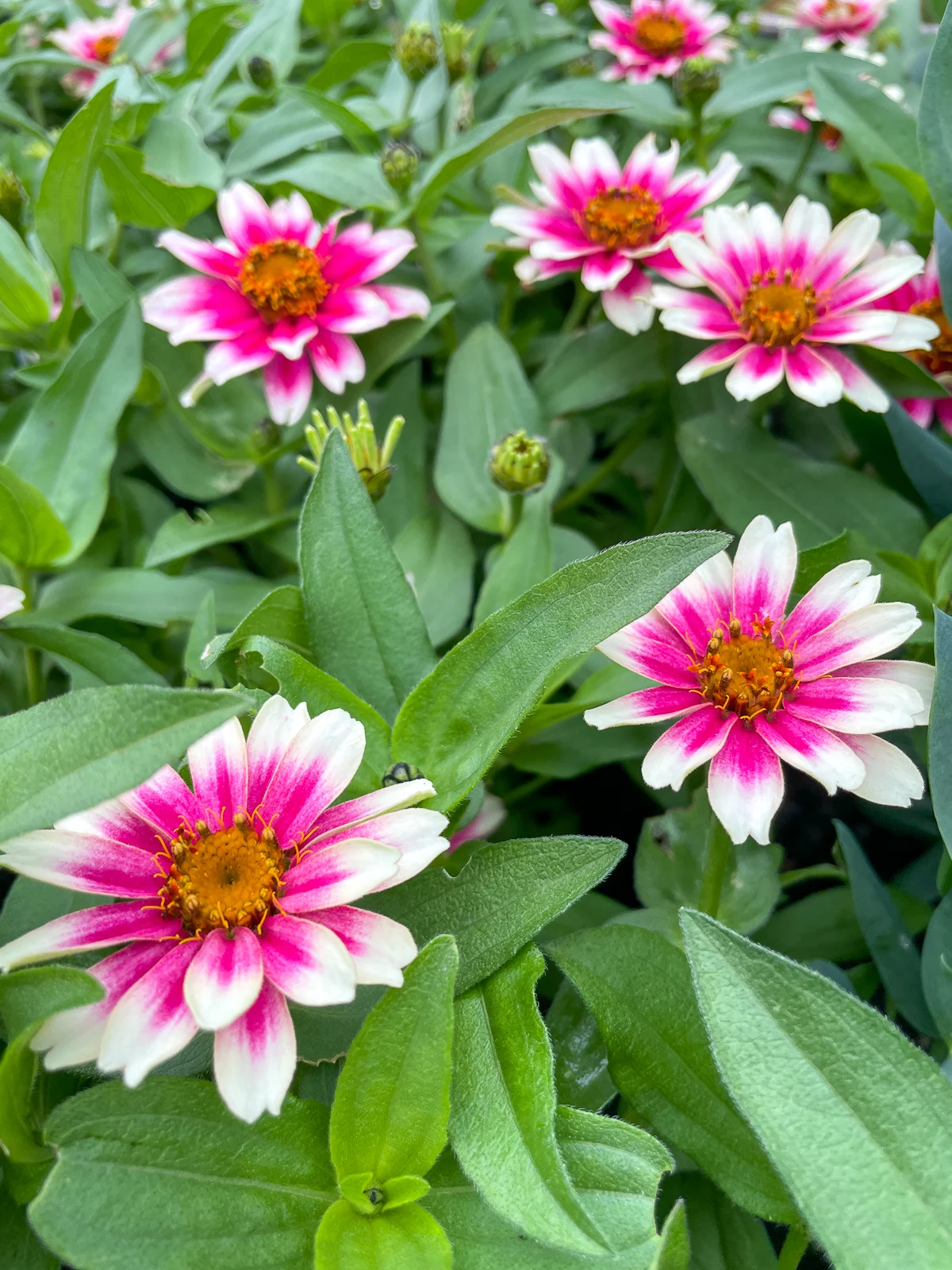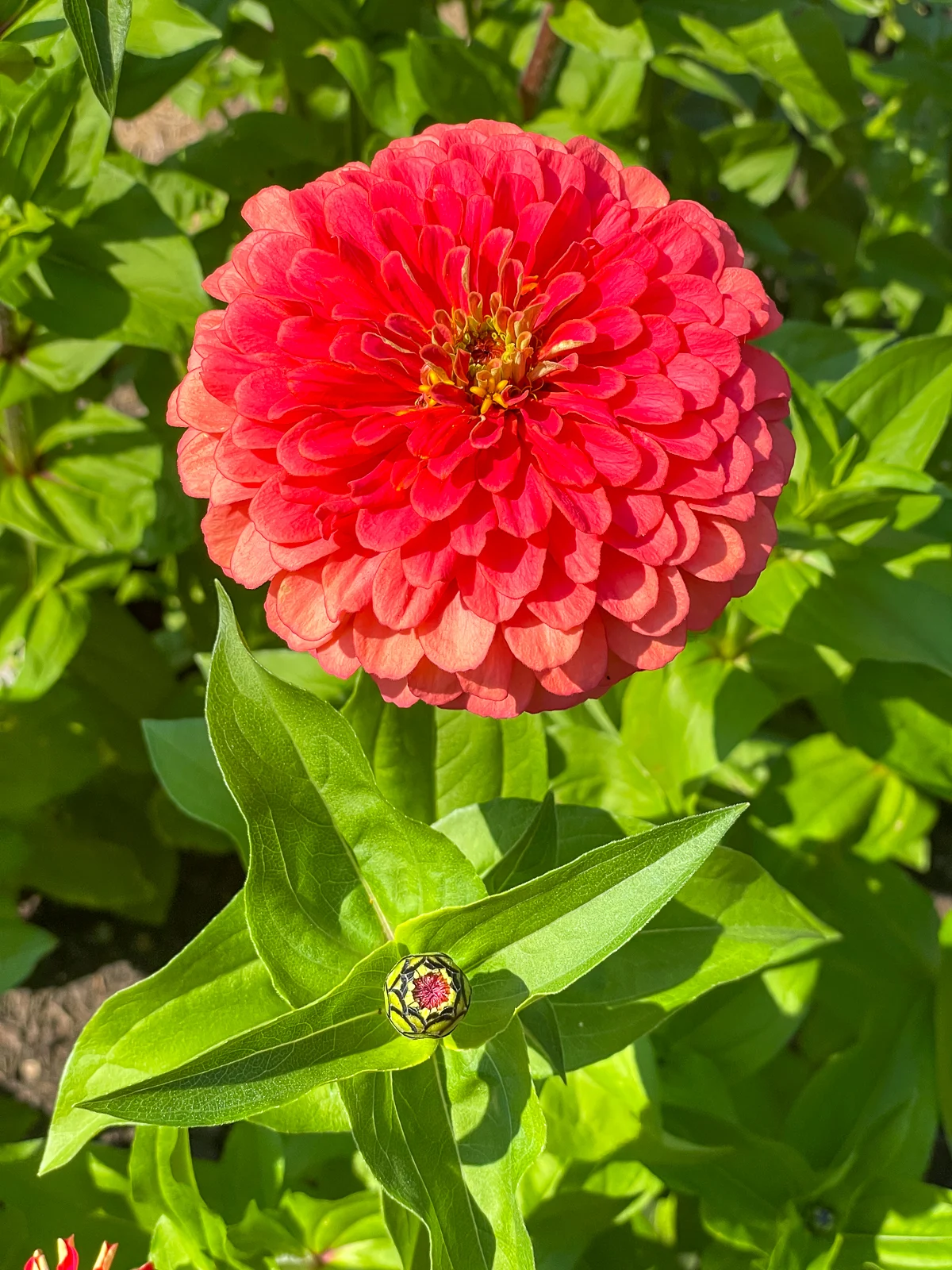Learn how to grow zinnias from seed with our step-by-step guide. Find tips on planting, care, and enjoying these vibrant flowers.

Zinnias are known for their vibrant colors and easy-to-grow nature. These flowers can add a splash of cheer to any garden, coming in various shapes and sizes to suit your aesthetic.
Zinnias also make excellent cut flowers, with tall varieties that can grow up to 4 feet. Petal types include single, semi-double, and double petal arrangements, so you can mix and match varieties in a bouquet.
In this article, I'll show you how to grow zinnias from seed, providing you with everything you need to nurture these beautiful blooms from the ground up.
Let's get growing!
This post contains affiliate links for your convenience. Purchases made through these links may earn me a small commission at no additional cost to you.
Zinnia overview
| Botanical Name | Zinnia elegans, angustifolia or marylandica |
| Plant Type | Annual flower |
| Plant Height | 8-48" (from dwarf to cut flower varieties) |
| Plant Spacing | 6-12" apart (depending on variety) |
| Sun Requirements | Full sun |
| Soil Requirements | Fertile, well-draining soil with pH between 6 and 7 |
| Water Requirements | Water deeply 2-3 times per week |
| Seed Depth | ¼" |
| When to Sow | Direct sow when soil temperature reaches 70°F Start indoors 4 weeks before soil temperature reaches 70°F |
| Germination | 5-7 days |
| Days to Maturity | 75-90 days |
| Pinching & Deadheading | Pinch when seedlings are 6-8" tall Deadhead to encourage more blooms |
| Common Issues | Powdery mildew, blight, leaf spot, Japanese beetles |
Zinnia varieties
There are two main species of zinnia with different growth habits.
Zinnia violacea (also known as Z. elegans) grows upright and has broad leaves and large flowers. Z. angustifolia has a low-growing habit, narrow leaves, and white, yellow, or orange flowers. However, many hybrids of these two types exist called Zinnia marylandica.

This year, I planted Senora, Queen Lime Blush, and Benary's Giant Coral in one of my raised garden beds. This mix of zinnias in complementary colors creates gorgeous bouquets that I can bring into the house!

What do zinnia seeds look like?
Zinnia seeds are flat, with one pointed end and one rounded end with a notch. They can be found in various shades of brown with a papery coating.

When to plant zinnia seeds
Timing is everything when it comes to planting zinnias. These sun-loving flowers thrive in warm weather, so it's essential to wait until the danger of frost has passed before sowing the seeds directly into the garden soil.
For most regions, this means planting zinnia seeds in the late spring to early summer, once the soil has warmed up. If you're unsure about the right time for your area, a quick check with your local gardening center or cooperative extension office can provide valuable insights.
Where to plant zinnias
Picking the right location for your zinnias can make a world of difference in their growth and bloom. Here are some pointers to help you select the best spot in your garden:
Full Sun: Zinnias love the sun! They thrive best when they receive at least 6-8 hours of direct sunlight every day. The more sun they get, the more blooms they'll produce.

Good Air Circulation: Planting zinnias in an area with proper air flow can help prevent issues like powdery mildew. Space them appropriately, and avoid cramming them into overly tight spots.
Well-draining Soil: Zinnias aren't fans of wet feet. Plant them in areas where the soil drains well. Raised beds or slightly elevated patches can be ideal if you're dealing with dense or clay-heavy soil.
How to plant zinnia seeds indoors
Zinnias are among the easiest flowers to start from seeds at home, making them an excellent plant for beginning gardeners and kids. The large seeds sprout quickly and grow with minimal care.
Start seeds indoors in small pots or sterilized seed trays. Keep the pots in a sunny place at a temperature of 70 to 80°F with moist soil until germination in five to seven days.

When the plants have their true leaves, fertilize them once weekly with a dilute fertilizer solution. Pot up to larger containers if the seedlings get root-bound.
Harden off the plants for about one week before transplanting, and transplant during cloudy weather or evening to prevent transplant shock.
How to plant zinnia seeds outdoors
You can also plant zinnia seeds directly in the ground as spring weather warms up.
Sow seeds about ¼ inch deep and 8 to 24 inches apart, depending on the variety. Dwarf zinnias likes the ones shown below can be spaced about 6 inches apart. Larger ones may need 12 inches or more between plants.

Once you've chosen your spot and prepared the soil, make a small hole with your finger or a stick. Drop the seed in, and lightly cover. Gently press down on the soil to ensure good seed-to-soil contact, which will aid in germination.
After planting, give the seeds a good, gentle watering. You want to moisten the soil without causing erosion or washing the seeds away. Using a watering can with a fine rose or a soft spray setting on a hose works best.

Until your seeds germinate, it's important to keep the soil consistently moist but not soggy. A light daily watering might be necessary, especially if you're in a particularly hot or windy location.
Zinnia seeds usually sprout pretty quickly, often within 5-7 days. Once you see those little green shoots popping up, you'll know your zinnias are off to a good start!
How to care for zinnias
Once your zinnias have sprouted and are on their way to showcasing their vibrant blooms, it's essential to keep up with some basic care and maintenance routines. Here's how to ensure your zinnias flourish:
Watering
Zinnias prefer a somewhat consistent watering routine. Aim to water them deeply a few times a week rather than a little every day, which encourages deeper root growth. Water early in the day to reduce evaporation and to allow leaves to dry, minimizing potential disease issues.

Allow the top inch of soil to dry out between watering once the plants are established. Avoid getting the leaves wet when you water because it can encourage fungal diseases.
Fertilizing
While zinnias aren't super demanding, feeding them with a balanced, slow-release fertilizer at the time of planting can give them a good start. If you notice their growth slowing down or their color dulling during the season, a water-soluble fertilizer can give them a boost.

Pinching and deadheading
Some gardeners swear by pinching back young zinnia plants when they're about 6 inches tall. Pinching out stems directly above leaves stimulates side branches and more blooms.

Zinnias will also produce more blooms if you regularly remove spent flowers, a process known as deadheading. Not only does this encourage more flowering, but it also keeps the plant looking tidy.
Pests and diseases
While zinnias are relatively robust, they can sometimes attract pests like aphids or suffer from diseases like powdery mildew. Regularly inspecting plants and addressing any issues early on can keep your zinnias in top shape.
The biggest pest issue I encounter when growing zinnias is slug damage. They totally destroyed the leaves of these Candy Stripe zinnias and really impacted their blooms. I planted these seeds months ago and they're just now starting to flower!

I deal with slugs eating my hostas as well, so I have a supply of Sluggo on hand all season. Just sprinkle it in the garden bed where you notice damage.
Now that you know how to grow zinnias from seed, you can enjoy their beautiful blooms every summer!
Check out these other flowers you can grow from seed!






